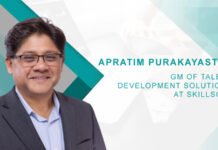Kristen, could you please share with us your professional journey and how you became the Chief People Officer at ZayZoon?
My journey to becoming a Chief People Officer is very unique, as my background is in accounting. I spent much of my career in small and mid-sized businesses, which evolved into operational leadership roles that oversaw the people function. In most or all of those roles there was never actually a person dedicated to People & Culture so you could say that I was thrown into doing it all. It wasn’t until my role as Chief Operating Officer at a law firm that I saw firsthand what could be accomplished with business performance by using People & Culture as a strategic lever. I was the key driver in a cultural revolution that led to an explosion of growth for a decades old business. Not only that, but we hit a peak where I’d see employees returning from vacation and running around to hug their co-workers because they missed them so much. I was hooked! I brought that passion for people and the focus on growing a team the right way to ZayZoon where I was able to set a solid foundation right from the start. Like many I’ve spoken to in this space, I didn’t go looking for People & Culture, it found me.
From your perspective, what are the implications of the employee nesting trend? Do you view it as beneficial or challenging for businesses?
Employee nesting is often mistaken for loyalty, but employers shouldn’t get too caught up in new trends. Instead, they should focus on building the right high-performance culture and programs to take advantage of those trends, like nesting, instead of trying to correct when there is already a problem. While nesting provides stability for employees, it also poses new opportunities for businesses to develop and maintain a strong people function. When HR has less of a focus on recruitment and retention, they can focus on enhancing core benefits and perks, expanding L&D initiatives, and doubling down on recognition and rewards.
Employers can demonstrate their commitment to employee well-being and career growth by investing in a range of benefits, from financial wellness programs to flexible work arrangements that support holistic well-being. In addition to enhancing retention, these initiatives boost engagement, fostering a stronger culture and higher productivity from nesters.
Business leaders should take the nesting phenomenon as an opportunity to build meaningful relationships with their teams. Through those connections, leaders can better understand what motivates employees, acknowledge feedback, take action, and develop a culture that makes employees want to grow with an organization.
How can HR leaders distinguish between genuine employee loyalty and mere nesting behavior?
Distinguishing genuine loyalty from nesting behaviors can be challenging because it varies from employee to employee, but it is crucial for effective workforce management. Here are some indicators that differentiate the two:
- Initiative and Proactivity: Loyal employees demonstrate initiative, are active contributors to their teams, and drive impact for the business wherever they can. They volunteer for projects, suggest improvements, and are proactive in sharing their ideas. Nesters will usually lack the initiative to take on additional responsibilities outside their immediate job scope, focus on maintaining a steady level of performance, and often create friction against any change.
- Career Development: Engaged and loyal employees seek opportunities for growth within an organization and level up alongside their team. They are interested in career advancement, and skill development, and they take advantage of company resources. In contrast, nesters show reluctance or limited interest in career development. This can manifest as indecision and an inability to articulate what they want to do.
- Leadership: You do not need to have a title to be a leader. A leader is someone who influences outcomes. Loyal employees demonstrate strong leadership qualities such as mentorship, coaching, and actively contributing to a team’s success. They innovate and want to figure things out. Nesters, however, are less inclined to take on responsibilities that involve anything that is outside their prescribed scope of work or projects. They prefer to simply meet the requirements for their current positions.
Managers who have strong relationships with their teams are the most equipped to identify nesting behavior, but they should always assume positive intent. Managers and business leaders should be proactive and challenge their teams to grow by presenting the right opportunities to tap unrealized potential. It’s not just about climbing the ladder, it’s about leaning into areas of interest and providing opportunities to participate in the right projects.
What are some effective strategies HR teams can employ to create a more engaging workplace that fosters long-term loyalty?
Creating an engaging workplace environment is essential for cultivating long-term loyalty among employees. Recognizing their contributions, providing regular feedback, and offering robust career development opportunities are key strategies that not only enhance productivity but also nurture a motivated and committed workforce.
- Recognition and rewards: Recognizing employees for their work reinforces the company’s values and motivates them. Be specific and make it personal. Ensure employees understand why you appreciate them and more importantly the impact they had on their team or the business. Tell them why they matter. Recognition can also help employees gain a sense of pride in their work because it shows other employees what great work looks like.
- Regular feedback: Ensuring regular actionable feedback and clear direct communication between employees and leaders is essential for creating a supportive work environment where employees have a voice, understand their strengths, and are aware of areas for improvement. Create safety to ensure you receive candid upward feedback and commit to clear action as a result of what you’re hearing. Feedback is a two-way street.
- Career Development Opportunities: Offering personalized development plans, workshops, and pieces of training that align with employees’ career aspirations, improve their job performance, and prepare them for future roles within the organization. Continuous learning leads to loyalty and retention as well as a motivated and engaged workforce. It’s no longer just about a career ladder. Long-term retention is about a career “jungle gym” where movement doesn’t need to be in a single direction. If you want your employees to grow with the organization, they are more likely to stay if they see multiple options for where they can grow.
Could you share examples of how ZayZoon has successfully implemented initiatives to enhance employee engagement and retention?
Employee engagement and retention is more of a journey than a final destination. At ZayZoon, we have grown and grown up so quickly in a short amount of time. That meant we needed to continually evolve our programming to meet the needs of the team. In the early days, we would do 1:1 meetings between our C-Suite leaders and individual team members to ensure we didn’t lose touch with our team. Today we work to ensure that our culture can be felt throughout every stage of the employee experience, starting from recruiting. We bring our core values to life during our daily company-wide “Scrum” meetings through shout-outs where anyone can provide recognition to another team member for going above and beyond in demonstrating one of our core values.
This meeting is also one of the many ways we ensure fast and consistent communication company-wide. This level of daily recognition, ensures all our employees feel their work is being acknowledged and celebrated by their peers or direct leaders. As a bonus, we also have a system that allows those shoutouts to be captured and easily served up to managers during performance reviews.
Beyond that, we are very intentional about how we talk about our vision. Every quarter we go through strategic planning that allows the strategy created by our leaders to be distilled into meaningful priorities and projects for the team at large. Like most organizations, we’re far from perfect but we are committed to maintaining employee engagement and we move with intentionality. We launch quarterly engagement surveys, using those insights to make commitments to action for our team. We create safety around “Ask Us Anything” sessions with our founders to ensure we demonstrate transparency whenever possible. If you zoom out, it all comes back to the employee experience we want to create because without understanding what you are trying to do, you end up with too many trendy but otherwise disjointed tactics.
How important is it for employees to feel appreciated in their roles, and what impact does this have on retention?
We live in a society where we all spend more time on the job in our waking hours than doing anything else. At the end of the day, we all just want that time spent to have meaning. Most people want to be a part of something bigger than themselves. They want to know that they matter. Recognition and genuine appreciation are incredibly important in reminding employees why they matter to their team, the company, or the customers they serve. It is the role of leadership to help their team have a clear line of sight between their contribution, and the greater vision of the company. Through appreciation, employers can reinforce an employee’s sense of purpose within their work. In fact, data shows that employees who receive strong recognition have an 89% higher sense of determination and drive, generate 2x as many ideas per month, and are 33% more likely to be proactively innovating. Strong recognition is a critical part of any high-performing culture, driving productivity and bolstering employees’ sense of value and belonging within their organization.
What opportunities for growth and development should companies offer to keep employees motivated and committed?
Growth and development look different in each company. For some, it might be a dedicated learning and development program, tuition reimbursement assistance, or mapped-out career plans for each role. For others, like small businesses strapped for resources, development opportunities can be centered around mentorship programs, leveraging opportunities that align with available grants, or leaning specifically into those team members identified with high potential for growth. Regardless, managers should work to build relationships with their team members and regularly talk about the opportunities that the team member wants. This is the best way to find opportunities to challenge their employees to grow, especially when they see unrealized potential. Opportunities like participating in a cross-departmental project, shadowing a team that they work closely with, or offering temporary job rotations can help expose employees to new opportunities that align with their long-term career goals. Understanding which opportunities will not only resonate with employees, but also align with the future needs of the business requires thoughtfulness in order to lead to a win-win for everyone.
What personal strategies do you use to ensure employees feel valued and engaged in your organization?
A strong leader will focus on providing support, removing barriers, and getting out of the way! I am incredibly passionate about creating line of sight for the teams I lead. What is the vision? Why does it matter, and most importantly why should it matter to them? Once they are bought in, I help them to plan the work and work the plan. We hold each other accountable as a team. I help them to stop and celebrate the wins. Most importantly, I lean into the hard part of leadership. I don’t shy away from difficult conversations and I create the safety for them to come to me with difficult topics. My team knows that I value their opinions because I constantly ask for it and I don’t shut them down if they say something I don’t want to hear.
What advice would you give to HR leaders who are looking to improve employee retention and loyalty?
Don’t obsess over new workplace trends. Instead, focus on building the right culture that exemplifies the values of your organization. Be intentional about the culture you create and ensure employees understand how they can contribute to the broader company vision. When employees feel they are a part of something meaningful they feel a strong sense of fulfillment and belonging, leading to stronger motivation and cultivating true employee loyalty.
Finally, what are your thoughts on the future of employee retention, and how do you see it evolving in the coming years?
Employees are looking for stability and workplaces that offer more than just a paycheck. Nesting is just another trend that shows the importance of people strategies and new opportunities to double down on the employee experience to create a meaningful culture. Looking ahead, several trends will continue to impact businesses’ ability to recruit and retain top talent including:
- Flexibility: Flexible work arrangements encourage better work-life balance, reduce stress and burnout, and help attract the best talent outside of traditional office locations.
- Employee well-being: Comprehensive well-being programs help foster a positive workplace culture, develop a sense of belonging, and show a concern for employees outside of the workplace.
- Purpose-Driven Work: Organizations that can help employees understand how they contribute to the company’s bigger picture help create a sense of purpose and fulfillment, leading to higher engagement and employee loyalty.
Explore HRTech News for the latest Tech Trends in Human Resources Technology.

Kristen McGill, Chief People Officer at ZayZoon
Kristen McGill is the Chief People Officer at ZayZoon, with nearly six years of experience at the company. Since February 2024, she has been instrumental in shaping the company's People & Culture strategy, implementing a 12-quarter roadmap that aligns performance management with career development and drives a high-performance culture. Kristen has also led a refresh of the total compensation strategy, rolled out a performance bonus program, and built an internal recruitment function to support the company's rapid growth. Before her current role, Kristen served as ZayZoon's Chief Operating Officer from January 2020 to January 2024. She was a key player in scaling the company from start-up to Series B+, building multiple departments, and overseeing critical HR and IT system implementations. Kristen's leadership has been pivotal in fostering company-wide buy-in and operational excellence.












